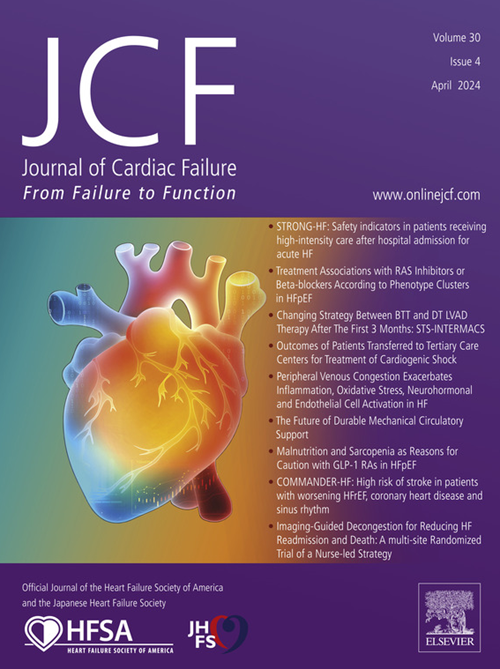Right Ventricular Mass Oversizing Is Associated With Improved Post-transplant Survival in Heart Transplant Recipients With Elevated Transpulmonary Gradient
IF 8.2
2区 医学
Q1 CARDIAC & CARDIOVASCULAR SYSTEMS
引用次数: 0
Abstract
Background
This study evaluates the effects of pre-transplant transpulmonary gradient (TPG) and donor right ventricular mass (RVM) on outcomes following heart transplantation.
Methods
UNOS registry was queried to analyze adult recipients who underwent primary isolated heart transplantation from 1/1/2010 to 12/31/2018. The recipients were dichotomized into 2 groups based on their TPG at the time of transplantation, < 12 and ≥ 12 mmHg. The outcomes included 5-year survival and post-transplant complications. Propensity score-matching was performed. Subanalysis was performed to evaluate the effects of donor-recipient RVM matching, where a ratio < 0.85 was classified as undersized, 0.85–1.15 as size-matched, and > 1.15 as oversized.
Results
We analyzed 17,898 isolated heart transplant recipients, and 5129 (28.7%) recipients had TPG ≥ 12 mmHg at the time of transplantation. The recipients with TPG ≥ 12 mmHg experienced significantly lower 5-year survival rates (78.4% vs 81.2%; P < 0.001) compared to the recipients with TPG < 12 mmHg, and this finding persisted in the propensity score-matched comparison. The recipients with TPG ≥ 12 mmHg experienced a higher rate of post-transplant dialysis and a longer duration of hospitalization. Oversizing the donor RVM considerably improved the 5-year survival among the recipients with TPG ≥ 12 mmHg, comparable to those with TPG < 12 mmHg.
Conclusion
Elevated pre-transplant TPG is associated with significantly reduced post-transplant survival. However, oversizing the donor RVM is associated with improved survival rates in recipients with elevated TPG, resulting in improved survival that is comparable to that of recipients with normal TPG. Therefore, careful risk stratification and donor matching among recipients with elevated TPG is essential to improve outcomes in this vulnerable population.

右心室质量过大与跨肺梯度升高的心脏移植受者移植后存活率的提高有关。
背景:本研究评估了移植前跨肺梯度(TPG)和供体右心室质量(RVM)对心脏移植后预后的影响:本研究评估了移植前跨肺梯度(TPG)和供体右心室质量(RVM)对心脏移植术后预后的影响:方法:查询 UNOS 注册表,分析 2010 年 1 月 1 日至 2018 年 12 月 31 日期间接受原发性离体心脏移植的成年受者。根据受者移植时的TPG(1.15为超大)将其分为两组。结果分析了17898例孤立心脏移植受者,其中5129例(28.7%)受者在移植时TPG≥12 mmHg。TPG≥12毫米汞柱的受者5年存活率明显较低(78.4% vs 81.2%,pConclusion):移植前TPG升高对移植后存活率有负面影响。然而,过大的供体RVM与TPG升高的受者生存率改善有关,其改善的生存率与TPG正常的受者相当。因此,对 TPG 升高的受者进行仔细的风险分层和供体匹配对于改善这一弱势群体的预后至关重要。
本文章由计算机程序翻译,如有差异,请以英文原文为准。
求助全文
约1分钟内获得全文
求助全文
来源期刊

Journal of Cardiac Failure
医学-心血管系统
CiteScore
7.80
自引率
8.30%
发文量
653
审稿时长
21 days
期刊介绍:
Journal of Cardiac Failure publishes original, peer-reviewed communications of scientific excellence and review articles on clinical research, basic human studies, animal studies, and bench research with potential clinical applications to heart failure - pathogenesis, etiology, epidemiology, pathophysiological mechanisms, assessment, prevention, and treatment.
 求助内容:
求助内容: 应助结果提醒方式:
应助结果提醒方式:


